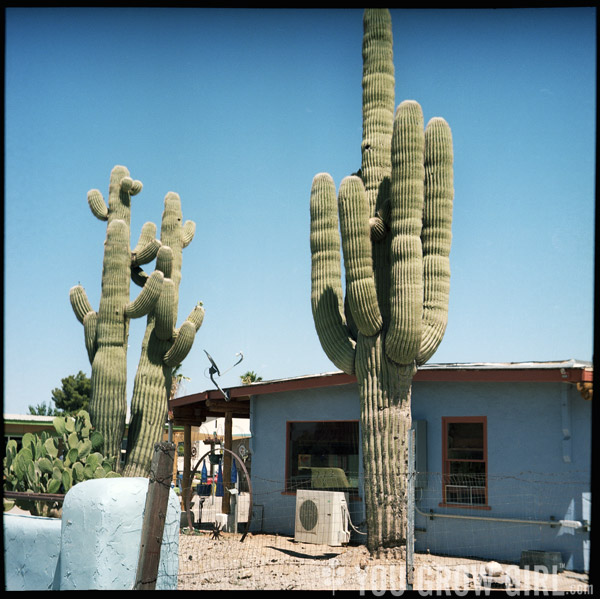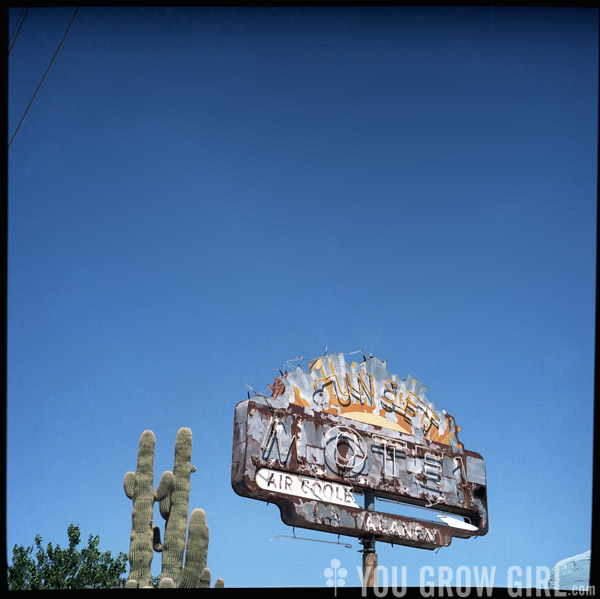
They were so much more than I imagined they would be. Bigger. More imposing. Majestic. Awesome.

This photo is for those of you who asked if I saw any old motels while on the road. Indeed I did.
I saw my first Saguaro cactus (Carnegia giganteus) at Desert Botanical Garden in Phoenix, but the ones that really seemed to matter were seen on the side of the road, a smattering of smaller plants here and there when we finally reached the outskirts of the sprawling Phoenix suburbs, and growing larger and more prevalent as we drove further away from the city. The best sighting was as we drove through the Tohono O’odham land near the Mexican border. The land was thick with them and that is where I got to see the most amazing oddities: plants with crazy, misshapen arms and even a few that were crested.


Saguaro Cactus Factoids
- Saguaros are very slow growing. It takes them 50-75 years to grow their first arm. All-in-all they can grow to be as tall as 50 feet. Whenever I saw a particularly large saguaro my first thought was, “You are very old my friend.“
- They can weigh several tons. Years back I caught a documentary on television about Saguaros that mentioned people being crushed under the weight of a fallen saguaro arm. Of course, my immediate reaction was, “I have got to go and see them.“
- Birds make nests inside saguaro trunks just like any other tree. Just about every saguaro I saw had a visible hole in it, which really drove home the fact that while they may be cacti, they are also desert trees.
- The fruit are very edible, in fact, they are considered to be the best-tasting of any cactus fruit. I truly regret that I did not get to taste one. However, I did purchase 2 bottles of saguaro cactus syrup from the Tohono O’odham Community Action store in Sells, AZ.
The ranger at Organ Pipe National Monument told me that they are best when picked just before they burst open. - Traditionally, the saguaro fruit is very important to the O’odham people, and its harvest in late June/early July corresponds with the beginning of monsoon season, which is, in a way, the start of a new year or new life in the desert.
- The seeds are also edible and according to the book, “Indian Uses of Desert Plants” by James W. Cornett, the seeds were ground with water to make bread. I bought a bag of seed from the same place that I got the syrup and they suggesting toasting them like sesame or baking them in bread much as you would poppy seed. So far I have sprinkled a few on my morning granola along with a splash of the syrup.
So beautiful what a wonderful reminder of the Arizona desert.
I was wondering how old they were when looking at the photos. The size is simply amazing!
It’s beautiful, no doubt!
In a word it is “AWESOME” :D
Do you know how far underground they grow? It must be far to support such a large size topside!
I don’t but that’s a great point.
Did you happen to see any Elf Owls?! They’re one of the bird species that frequently nests in Saguaros and they are beyond adorable…
I would love to have a cactus tree! They are so beautiful!
Your first picture really gives me a better perspective of their size than I had before. most pictures of them that I see are out away from civilization, and the Monument Valley type views are very hard to scale.